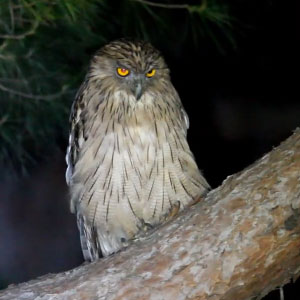Magazine | Voyages
Observer le Kétoupa brun depuis un bateau de promenade !

Kétoupa brun (Ketupa zeylonensis) dans la région d’Antalya (Turquie) en juin 2010.
Image extraite d’une vidéo réalisée par Murat Cuhadaroglu
Introduction
On compte plusieurs espèces d’oiseaux « mythiques » dans le Paléarctique occidental, du fait de leur rareté ou de leur présence dans des milieux difficiles d’accès : c’est certainement le cas du Kétoupa brun (Ketupa zeylonensis), un grand hibou qui a la particularité de pêcher des poissons et des crustacés d’eau douce. Son aire de répartition s’étend de la Turquie à l’ouest jusqu’au nord de la Chine, en passant par la péninsule malaise.
Dans le Paléarctique occidental niche la sous-espèce B. z. semenowi, mais elle est devenue très rare et très locale. Elle a ainsi disparu d’Israël, de Syrie et de Jordanie et ne semble subsister qu’en Turquie, avec une population estimée à moins de dix couples.
Un couple avait été découvert en 2004 dans l’Antalya Daglari, une chaîne de montagnes proche de la ville d’Antalya. En juillet 2009, jusqu’à six oiseaux avaient été photographiés et enregistrés dans la région d’Antalya.
En 2011, lors d’une promenade en bateau sur le lac de réservoir d’Oymapinar, situé entre Antalya et Adania, une famille a photographié un individu posé dans la cavité d’une falaise du « Little Canyon », une petite « corne » (ou cornée, ou vallée inondée) du lac, grâce aux indications du capitaine. Les photos furent ensuite identifiées par l’équipe du site web danois Netfugl.
Depuis, des ornithologues danois et néerlandais se sont rendus sur place, et ils ont pu constater la relative facilité d’observation de cette rareté dans ce spot.
Antony Faure y a séjourné en mai 2012, et il nous a communiqué d’autres photos et des informations utiles.
Abstract
The Brown Fish-owl (Bubo zeylonensis or Ketupa zeylonensis) is a large owl (around 55 cm in length and weighing 2–2.5 kg when fully grown) with prominent « ear » tufts which inhabits the warm subtropical and humid tropical parts of continental Asia and some offshore islands. The upperparts are reddish brown and heavily streaked with black or dark brown. The underparts are buff to whitish, with dark streaks and finer brown barring. The throat is white and can be conspicuously puffed, while the facial disk is indistinct. The irides are yellow, the feet a duller yellow, and the bill is dark.
This species is very nocturnal but it can often be located by the small birds that mob it while it is roosting in a tree. It feeds mainly on fishes, frogs and aquatic crustaceans; amniotes, in particular terrestrial ones, are seldom taken. If hungry, Brown Fish-owls will scavenge carrion.
Three to four subspecies are accepted today : the one that can be watched in Western Palearctic is B. z. semenowi, now very rare, with a small population (10 pairs estimated) in wooded mountainous areas in Souther Turkey, in Antalya region. A pair was discovered in 2044 in the Antalya Daglari ranges, then up to six birds were photographed in July 2009 in the Antalya region.
Until this year, it was a very difficult bird to to watch due its scarcity and ruggous habitat, but a bird was simply photographied in 2011 by a family on holiday in Turkey, on a guided boat trip on the Oymapinar Baraji reservoir ! Since the family didn’t know which owl it was, the photos were forwarded to the father of one of the participants. After the identification was given, the website Netfugl.dk has tried to solve the puzzle in order to forward as much detailed information about the record as possible. The bird was sitting in the part called « Little Canyon », a small flooded valley to the southeast in the Green Canyon/Oymapinar Baraji area.
Danish and Dutch birds visited the area in June and July 2011 and they quite easily watched and photographied one to three birds in the Little Canyon…
Poursuivez la lecture de cet article, en vous abonnant dès maintenant !
Découvrez les Archives d’Ornithomedia.com
Pour seulement 10,00 €TTC/an (ou 6,00 € les 6 mois)
Profitez de plusieurs centaines d’articles en accès illimité et sans aucun engagement.
Compléments
À lire sur le web
- Jean Chevallier, le dessinateur et peintre animalier bien connu, s’est rendu sur place en mai 2012 et a réalisé plusieurs dessins : http://jeanchevallier.jimdo.com
- La galerie de photos de Rifat Uzun : http://www.panoramio.com/user/669673?with_photo_id=51835406
Ouvrages recommandés
- Le guide Ornitho de L. Svensson et al
- Birds of the Middle East de Richard Porter (Auteur), Simon Aspinall (Auteur)
Sources
- Trakus. 7470 / Balik baykusu / Brown fish owl / Ketupa zeylonensis. http://www.trakus.org
- Dutch birding (2011). Bruine Visuil. http://www.dutchbirding.nl/news.php?id=642
- Ernst Albegger (2011). Österreicher-Twitch in die Türkei zum Fischuhu. Club300. http://www.club300.at/node/26295
- CNN Turk.com (2010). Balik baykusu Toroslar’da ortaya çikti. date : 10/08. http://www.cnnturk.com
- Netfugl.dk (2011). The gallery : Brown Fish Owl (Ketupa zeylonensis). Date : 17/07. http://www.netfugl.dk/pictures.php?id=showpicture&picture_id=41512
- Malu (2010). Green Canyon, Turkey. date : 22/11. http://www.bukisa.com/articles/401374_green-canyon-turkey




 2 commentaires
2 commentaires
2 commentaire(s) sur ce sujet
Participer à la discussion !FRANK DHERMAIN
MARSEILLE
Posté le 25 janvier 2024
Sinon, il y a aussi la possibilité de demander à un pêcheur de vous emmener sur place voir le Kétoupa. Ismet nous a ainsi conduit directement sur le spot, nous a laissé aussi longtemps qu’on le souhaitait (pas trop par peur du dérangement en ce qui nous concerne), ce qui a autorisé d’excellentes photos malgré des conditions difficiles (gorge à l’ombre, et matériel de l’époque (2014) pas aussi performant qu’aujourd’hui, pour 25 € par personne, le même prix que la croisière où on ne le voit que 5 minutes. Mais je ne sais pas comment vous partager ces photos.
Ornithomedia
sevran
Posté le 25 janvier 2024
Bonsoir, merci beaucoup ! Vous pouvez nous en envoyer par courriel à david.bismuth@ornithomedia.com